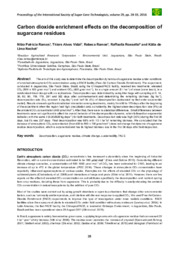Carbon dioxide enrichment effects on the decomposition of sugarcane residues.
Carbon dioxide enrichment effects on the decomposition of sugarcane residues.
Author(s): RAMOS, N. P.; VIDAL, T. A.; RAMOS, R.; ROSSETTO, R.; NECHET, K. de L.
Summary: Abstract: The aim of this study was to determine the decomposition dynamics of sugarcane residue under conditions of enriched atmospheric CO2 concentration using a FACE facility (Free-Air Carbon Dioxide Enrichment). The experiment, conducted in Jaguariúna, São Paulo State, Brazil, using the ClimapestFACE facility, received two treatments: elevated CO2 (550±100 ?mol mol-1) and ambient CO2 (400 ?mol mol-1), for a single amount (5 t ha-1) of straw (cane trash), in a randomized-block design with six replications. Decomposition was determined by using litter bags with sampling at 0, 14, 36, 60, 90, 119, 179, 291 and 362 days after commencement and determining the remaining biomass (kg ha-1), decomposition rate (%), constant k(kg.day-1) and half-life (t½) of decomposition (calculated by first-order exponential model). Results showed significant statistical interaction among treatments, mainly from 90 to 179 days after the beginning of the experiment when the region had high precipitation and, coincidently, the highest straw decomposition rate (4%) at the ambient CO2 concentration (400 ?mol mol-1). After that, there were no statistical differences. Small differences between treatments were not significant to affect the overall behavior of the decomposition dynamic, which followed an exponential behavior, with the same k(0.002929 kg days-1) for both treatments. Decomposition ratio was high (33%) during the first 36 days, but t½ was 237 days. Final decomposition was 69% with 1.5 t ha-1 of remaining biomass. We concluded that the increase of atmospheric CO2 concentration (from 400 to 550±100 ?mol mol-1) does not change the dynamic of sugarcane residue decomposition, which is exponential and has its highest biomass loss in the first 36 days after field deposition.
Publication year: 2016
Types of publication: Paper in annals and proceedings
Unit: Embrapa Environment
Observation
Some of Embrapa's publications are published as ePub files. To read them, use or download one of the following free software options to your computer or mobile device. Android: Google Play Books; IOS: iBooks; Windows and Linux: Calibre.
Access other publications
Access the Agricultural Research Database (BDPA) to consult Embrapa's full library collection and records.
Visit Embrapa Bookstore to purchase books and other publications sold by Embrapa.

